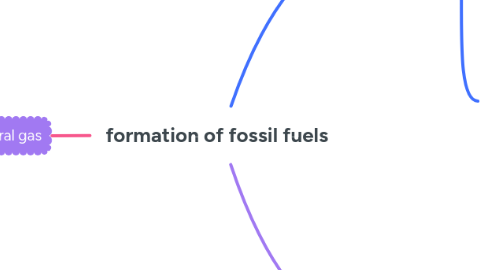
1. natural gas
1.1. a mixture of gases containing mainly methane
1.2. Like oil, natural gas is a product of decomposed organic matter, normally from ancient marine microorganisms, deposited over the past 550 million years.
1.3. has been forming over the past 550 million years.
1.4. in its pure form, natural gas is a colourless, odourless gas composed primarily of methane
1.4.1. methane is the simplest and lightest hydrocarbon, it is a highly flammable compound with only one carbon atom surrounded by four hydrogen atoms atoms (CH4).
1.5. 1.organic material mixed with mud, silt, and sand on the sea floor, gradually becoming buried over time
1.5.1. 2. because of the anaerobic environment and the increasing amounts of heat and pressure, the organic matter broke down and that converted it into hydrocarbons
1.5.1.1. 3.the lightest of these hydrocarbons are in a gaseous state under normal conditions and are known as natural gas. In its pure form, natural gas is a colorless, odorless gas composed primarily of methane.
2. coal
2.1. coal was formed in the carboniferous period
2.1.1. the carboniferous period started about 354 million years ago and lasted for about 64 million years, until 290 million years ago
2.2. Coal is a fossil fuel that is combusted and used to generate electricity
2.3. 1. plant debris accumulated and over time, got buried under layers of mud and sand
2.3.1. 2. under all the layers of mud and sand, the plant debris decomposition was slowed down due to the anaerobic conditions
2.3.1.1. 3. the material sinks under more sediment and because of the increased weight the materials are exposed to more heat and pressure
2.3.1.1.1. 4. the increased heat and pressure releases moisture content and volatile materials, the carbon content and quality of coal increases with the newly added moisture
2.4. the process of forming coal is called coalification
3. crude oil
3.1. Crude oil is a fossil fuel that is used to make plastics, pharmaceuticals and petrol and diesel
3.2. 1. the remains of living organisms (plankton) are buried under the mud and rock
3.2.1. 2. layers of mud and rock generates lots of heat and pressure which turns the remains into crude oil
3.2.1.1. 3. when oil is less dense, then water so it moves through porous rock, eventually it reaches non-porous rock and becomes trapped
3.2.1.1.1. 4. crude oil is extracted by drilling it out if the ground
